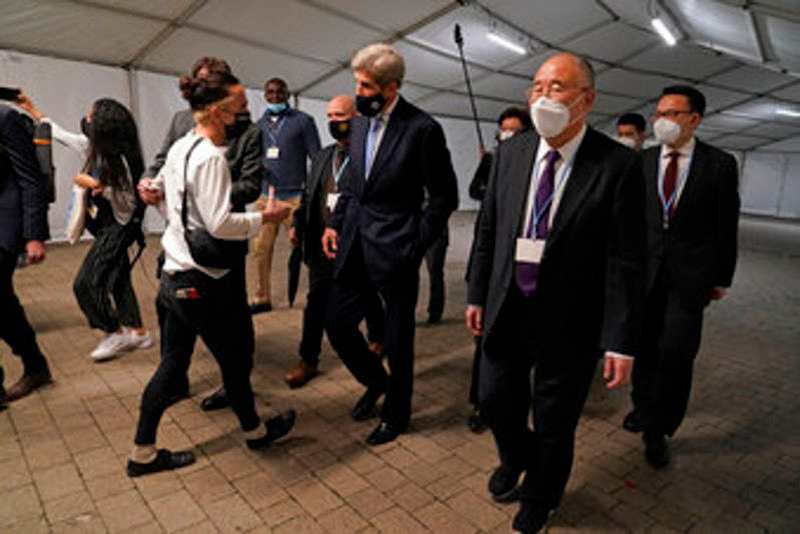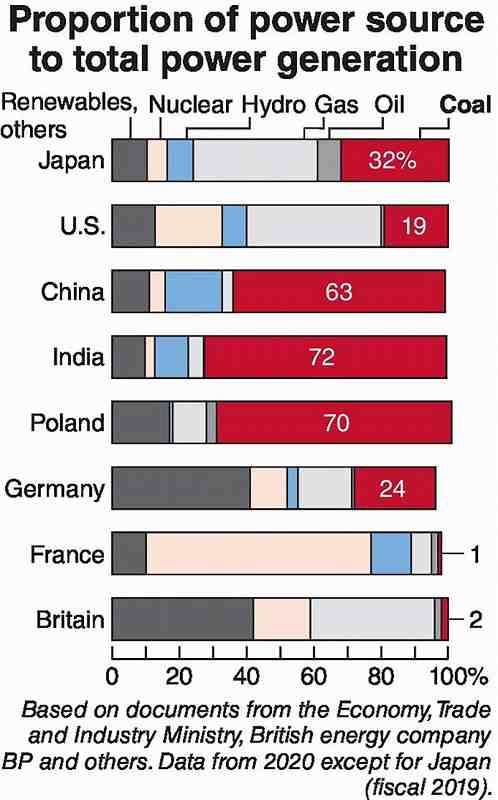
China’s chief negotiator Xie Zhenhua, right, walks with John Kerry, United States Special Presidential Envoy for Climate, at the COP26 U.N. Climate Summit in Glasgow on Friday.
November 16, 2021
GLASGOW — The 26th session of the Conference of the Parties to the U.N. Framework Convention on Climate Change (COP26) concluded with some tangible achievements, such as including in its agreement the de facto goal of limiting temperature increases to 1.5 C and the phased reduction of coal-fired power generation. However, it also showed that gaps remain between developed countries and developing countries.
“I apologize for the way this process has unfolded, and I’m deeply sorry,” said COP26 President Alok Sharma, just before the Glasgow Climate Pact was adopted on Saturday. “I also understand the deep disappointment, but I think as you have noted, it’s also vital that we protect this package.”

Sharma had called for a phase-out of coal in the first draft of the agreement presented on Nov. 10. This wording was met with a fierce backlash from India and China, leading to a change from “phase-out” to “phasedown.”
The two countries reacted this way because of their energy situations. Coal-fired power accounts for over 70% of India’s total power generation and for more than 60% in China. An important declaration made at an international conference could force a drastic change in their energy policies.
Many revisions were made to the draft. On Saturday, the final day of the conference after the schedule was extended by one day, India’s Environment, Forest and Climate Change Minister Bhupender Yadav called for a further revision at an informal meeting, questioning whether anyone could expect developing countries to make commitments on coal and fossil fuels. Representatives from India, China, the United States and the European Union then went on to have talks.
At the last plenary session held immediately after, India demanded that the word “phase-out” be changed to “phasedown.” The EU did not oppose the change, although it expressed disappointment, and Sharma also accepted it. The change is believed to have been the result of talks among the four parties to seek a compromise, a move that was criticized by some. A Swiss delegation said the pact was watered down through a process that lacked transparency.
Goal of 1.5 C
The pact also includes a clause stating that parties should “pursue efforts to limit the temperature increase to 1.5 C” above preindustrial levels by the end of this century. This is believed to have effectively made into a target the figure of 1.5 C, which had previously been presented as a level that nations should strive toward.
Britain wanted to realize some substantial achievements as the host country, and proceeded to adjust the wording through informal talks. The clause’s inclusion was approved by developed countries as well as island nations such as Tuvalu.
Oil-producing countries including India, Russia, and Saudi Arabia reportedly were opposed to the proposal, saying that developed countries had already emitted a large amount of greenhouse gases and so they were allowed to do the same.
The figure made it into the pact agreed upon by all 197 parties, despite some having been pessimistic. “This could send a strong message of political will,” said one Japanese government official.
Lingering dissatisfaction
However, keeping the temperature rise to 1.5 C will be very difficult. It cannot be achieved unless each country raises or reconsiders their targets on greenhouse gas emissions.
The pact stipulates that actions should be in line with national circumstances.
This statement was included apparently out of consideration for developing countries. However, it will be difficult to find a common foothold if emerging economies with large emissions, such as China and India, resist raising their targets by citing “national circumstances.”
The United States, the EU and other developed countries are urging the parties to implement related measures in a proactive way. U.S. Climate Envoy John Kerry said the pact was the beginning of the efforts of the next decade. However, dissatisfaction remains among developing countries that the agreed financial support from developed countries and other support measures are insufficient.
The two-week discussions at COP26 highlighted that all parties could agree on a broad goal to prevent global warming, but their conflicting interests remain a hurdle.
"Science & Nature" POPULAR ARTICLE
-

Genome Study Reveals Milestone in History of Cat Domestication
-

Big Leap in Quest to Get to Bottom of Climate Ice Mystery
-

Security Camera Footage Vulnerable to Outside Access; Investigation Finds 3,000 Pieces Exposed Online
-

Japan Set to Participate in EU’s R&D Framework, Aims to Boost Cooperation in Tech, Energy
-

Paws on Parade: Nairobi’s Dogs Dazzle at ‘Pawchella’
JN ACCESS RANKING
-

Tokyo Economic Security Forum to Hold Inaugural Meeting Amid Tense Global Environment
-

Keidanren Chairman Yoshinobu Tsutsui Visits Kashiwazaki-Kariwa Nuclear Power Plant; Inspects New Emergency Safety System
-

Imports of Rare Earths from China Facing Delays, May Be Caused by Deterioration of Japan-China Relations
-

University of Tokyo Professor Discusses Japanese Economic Security in Interview Ahead of Forum
-

Japan Pulls out of Vietnam Nuclear Project, Complicating Hanoi’s Power Plans


























